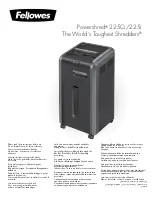
13
Repair works on the shredder must be carried out by
the manufacturer or by companies appointed by the
manufacturer respectively.
Make yourself familiar with the equipment before using it, by
reading and understanding the operating instructions.
Do not use the machine for unsuitable purposes (see “Proper
use” and “Working with the garden shredder”).
Provide a safe standing position and keep at any time the
balance. Do not lean forward. When placing material into the
shredder, always stand on the same level as the machine.
When placing material into the shredder, always stand on the
same level as the machine.
Be observant. Attend to what you do. Start working with ra-
tionality. Do not use the device when you are tired or under
the influence of drugs, alcohol or medicaments. One moment
of carelessness when using the device can result in serious
injuries.
Wear protective goggles, gloves and noise protection while
working with the machine.
Wear suitable work clothes:
- do not wear loose-fitting clothes
- slip-proof shoes
Within his area of work the operator is responsible for third
parties.
The machine must not be operated by children or young peo-
ple under 16 years of age.
Physically, sensorially or mentally handicapped persons or
persons who have no relevant experience and/or knowledge
are not allowed to operate the device, unless a person
responsible for their safety supervises them or instruct them
on how to use the device.
Children must be supervised to make sure that they do not
play with the device.
Keep children away form machine.
Never operate the machine if other persons are in the imme-
diate vicinity.
Never leave the device unattended.
Keep your workplace in an orderly condition! Untidiness can
result in accidents.
Choose a working position alongside the equipment or behind
it. Never stand near the ejection opening.
Never reach into the filling or ejection opening.
Keep your face and body away from the filling opening.
Do not overload the machine! You work better and safer in the
given performance range.
Only operate the machine with complete and correctly at-
tached safety equipment and do not alter anything on the ma-
chine that could impair the safety.
Do not alter the revolution speed of the motor, since this con-
trols the safe maximum operating speed, and protects the mo-
tor and all rotating parts against damage due to excess
speed.
Do not operate without the funnel.
Do not modify the device or parts of the device respectively.
Do not hose down the device with water. (Origin of danger
electric current).
Take into consideration environmental influences:
Do not use the device in moist or wet ambience.
Do not leave the machine standing in the rain or use when
raining.
Provide for good illumination.
To prevent danger of injury to fingers during assembly or
cleaning operations wear protecting gloves.
Do not transport the device when the motor is running.
Switch the machine off and remove the mains plug from the
socket when
attaching or removing the retaining basket
performing maintenance and cleaning work
eliminating faults
checking the connection cable for damage
and entanglement during operation
transporting
carrying out repair work
leaving unattended (even during short interruptions)
If the machine’s filling funnel or ejection slot is blocked switch
off the motor and disconnect the mains plug before removing
material from the filling funnel or ejection slot.
Check the machine for possible damage:
Before further use of the machine the safety devices must
be checked carefully for their proper and intended func-
tion.
Check whether movable parts function perfectly and do
not stick or whether parts are damaged. All parts must be
correctly installed and fulfil all conditions to ensure perfect
operation of the machine.
Damaged safety devices and parts must be properly re-
paired or exchanged by a recognized, specialist workshop;
insofar as nothing else is stated in the instructions for use.
Damaged or illegible safety labels have to be replaced.
Store unused equipment in a dry, locked place out of the
reach of children.
E
E
l
l
e
e
c
c
t
t
r
r
i
i
c
c
a
a
l
l
s
s
a
a
f
f
e
e
t
t
y
y
Design of the connection cable according to IEC 60 245 (H 07
RN-F) with a core cross-section of at least
1.5 mm
2
for cable lengths up to 25 m
2.5 mm
2
for cable lengths over 25 m
Long and thin connection lines result in a potential drop. The
motor does not reach any longer its maximal power; the func-
tion of the device is reduced.
Plugs and coupler outlets on connection cables must be made
of rubber, plasticised PVC or other thermoplastic material of
same mechanical stability or be covered with this material.
The connector of the connection cable must be splash-proof.
When running the connection line observe that it does not
interfere, is not squeezed, bended and the plug connection
does not get wet.
Wind off completely the cable when using a cable drum.
Do not use the cable for purposes for which it is not meant.
Protect the cable against heat, oil and sharp edges. Do not
use the cable to pull the plug from the socket.
Regularly check the extension cables and replace them if they
are damaged.
Do not touch a damaged connection cable before disconnect-
ing it from the mains. A damaged connection cable may cause
contact with live parts.
Do not use any defective connection cables.
When working outdoors, only use extension cables especially
approved and appropriately labelled for outdoor use.
Do not set up any provisional electrical connections.
Summary of Contents for ALF 2600
Page 2: ......
Page 149: ...149 ...
Page 150: ...150 ...
Page 151: ...151 ...
Page 152: ...152 ...
Page 153: ...153 1 2 3 4 6 5 ...
Page 154: ...154 7 8 9 ...
Page 155: ...155 ...














































